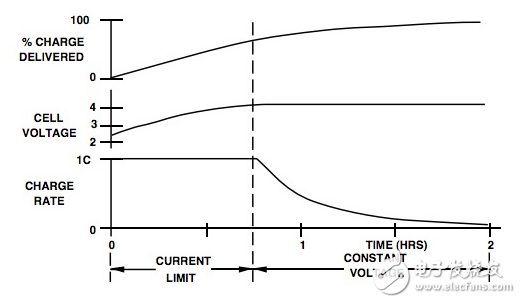
资料下载

建筑的电压监测到的能量收集设计保护锂离子电池
建筑的电压监测到的能量收集设计保护锂离子电池
锂离子电池在操作安全和整个电池寿命的考虑下,在一个狭窄的容差范围内工作。确保适当的工作电压水平,工程师可以建立电压监测功能为能量收集设计使用包括模拟设备,ATMEL,集成,Skyworks,意法半导体制造商的各种专用集成电路,德克萨斯文书,其中。
李离子电池通常充电的标称电压为4.20伏,耐受性约为50毫伏。根据一个特性充电配置文件(图1),电池通过恒定电流相达到这个设定点电压,快速地产生电荷水平和一个恒定电压相位,使电池达到最大充电水平。

Figure 1: The characteristic constant-current/constant-voltage charging profile for a lithium-ion cell brings a cell to its optimum charge point beyond which application of higher voltage results in cell stress and eventual damage (Courtesy of Texas Instruments)。
Although application of higher voltages beyond the 4.2 V set point can temporarily increase cell capacity, higher voltages result in internal changes in the cell. In cells subject to prolonged overvoltage conditions, lithium ions begin to plate on the anode, reducing the number of free lithium ions and resulting in loss of cell-charging capacity and overall cell lifetime. Furthermore, the continued application of voltage levels beyond the set point causes oxidizing effects that result in production of CO2. If overvoltage conditions are allowed to persist, increased CO2pressure can cause the cell‘s internal safety membrane to rupture, risking catastrophic thermal runaway and even combustion.
To prevent overvoltage conditions, engineers can select from a range of specialized devices including ICs designed to target typical Li-ion batteries with a limited number of cells, ICs designed for large multi-cell stacks, ICs designed specifically for ambient-energy–harvesting designs, or even software-based solutions using highly integrated MCUs.
声明:本文内容及配图由入驻作者撰写或者入驻合作网站授权转载。文章观点仅代表作者本人,不代表电子发烧友网立场。文章及其配图仅供工程师学习之用,如有内容侵权或者其他违规问题,请联系本站处理。 举报投诉
- 相关下载
- 相关文章





